When I was very young, and the NES first came out, there were many mysteries that came out of the box alongside the system itself. I’d heard rumors of how to get to “Minus One” world in NES. (HERE is a demo on how to pull it off…after 35 years of trying, I finally pulled it off this morning.) I didn’t understand how the Power Glove worked (hint: exact same way your phone lets you play Mario Kart). There were rumors of games that never came out, games that never WILL come out, and games that ended up being other games altogether.
And there was the greatest mystery of them all: how the fuck did the NES light-gun work?
For the 1/3 of a reader out there who can remember back to my history of Nintendo article many moons ago, one of the businesses Nintendo was involved with prior to cabinet video games was the “Laser Clay Shooting System”: a skeet shooting setup based in old bowling alleys (bowling was apparently a HUGE fad in Japan in the late 60s, and died just about as quickly as it started, leaving bowling alleys open all over with no bowlers). This system projected flying skeet on a screen with a 16mm projector, and tracked lasers shot out of the simulated shotgun with a complicated system of mirrors and “scored” shots. It was apparently pretty good, and just expensive at a time where the Japanese economy fell apart during the OPEC oil crisis. It’s not cheap keeping old bowling alleys open when everybody is broke.
Lightguns for cabinets or home systems weren’t a new idea either…they used a photo-diode (a light sensor) in/on the barrel and aimed at bright spots of light. While clever, it also meant you could run up the high score just by pointing the gun at a convenient light and blasting away. The system would reflect everything as a hit.
The Zapper didn’t work on either of those systems. Nintendo didn’t want something that could be cheated, and as a toy designed for home use and children, having a gun that shot actual lasers out of the end of it by a bunch of rowdy bored kids would have started the laser eye surgery revolution a decade early. That would probably lead to lawsuits, and Donkey Kong money wasn’t going to cover all of them. As a result, Nintendo came up with a completely new system.
The original solution, crafted for the Japanese FAMICOM, was called a Beam-Gun. Instead of shooting lasers, it worked on the photo-diode method. Instead of working on ANY light, however, pulling the trigger on the Beam-Gun did two things simultaneously: it briefly turned on the photo-diode, and it flashed the screen to black, except for the targets, which it outlined in white. All of this happened very, very quickly—CRT-TVs, the main screens of the 1980s, had a “refresh rate” of 60-85 Hertz…meaning the images on the screen refreshed 60-85 times a second. The screen flashed to black for 2 or 3 frames, so incredibly quickly. The end result, especially on smaller TVs, was that the flash to black was almost invisible to the naked eye. (this is also why Zapper won’t work on modern TVs. A halfway decent TV now runs on 120Hz, so the flicker rates don’t line up…the NES literally can’t keep up with modern tech.)
This new method had the advantage of being totally harmless to the shooters, and was pretty much spoof-proof as well.
The original Beam-Gun looked nothing like the Zapper we in the United States were sold, however. Clearly targeting at an adult audience and designed for the games Wild Gunman and Hogan’s Alley, the gun was far more realistic looking. It came with a leather holster and looked like a Wild-West six-shooter; the idea was to make it more realistic for the action shooting games that were originally released with the system. Additionally, after a few years, the Zapper when from the all-over grey to being covered in blaze orange, to ensure that the gun would not be confused for a real weapon.
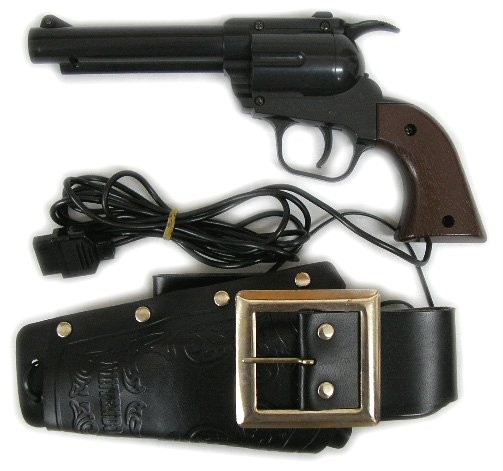
Nintendo smartly decided a more kid-friendly gun was appropriate for the US release. The Zapper, as the American gun was called, had a futuristic look to it, and was colored grey instead of the gun-metal that the Beam-Gun was. As the Zapper was eventually sold along with the game Duck Hunt, the Zapper moved away from realism into the “toy” category.
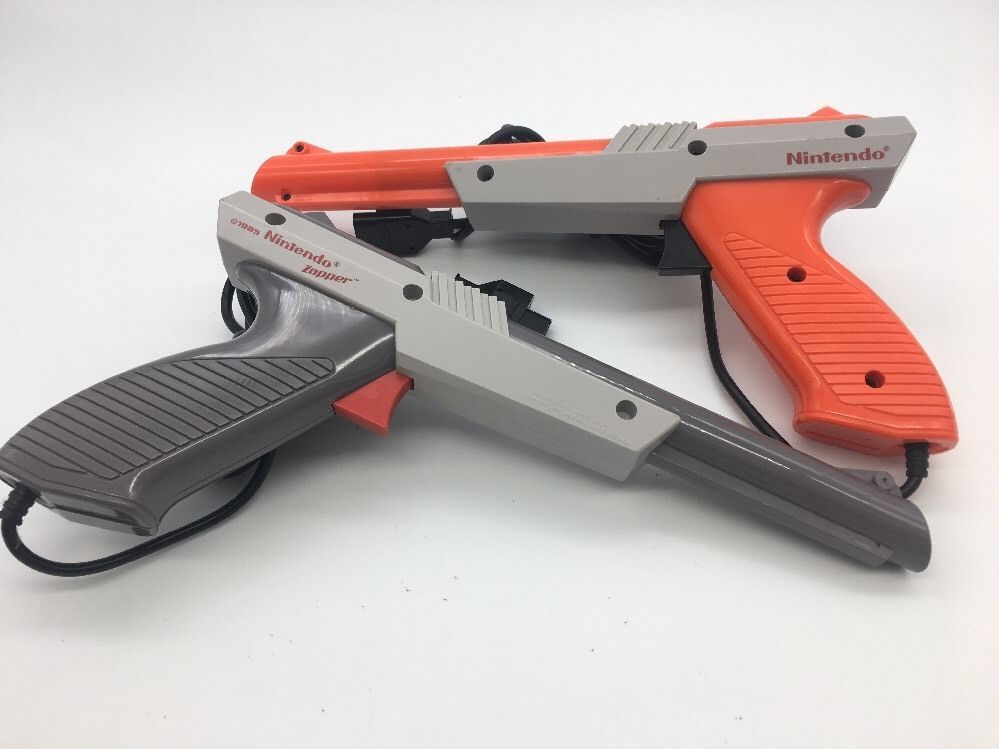
The games, however, were the same for both the FAMICOM and the NES. All three light-gun games were sold on initial release day; Hogan’s Alley and Wild Gunman were always sold independently, while Duck Hunt would eventually be paired with Super Mario Bros on the same cartridge and sold in a set with the NES, two controllers, and the Zapper.
Hogan’s Alley
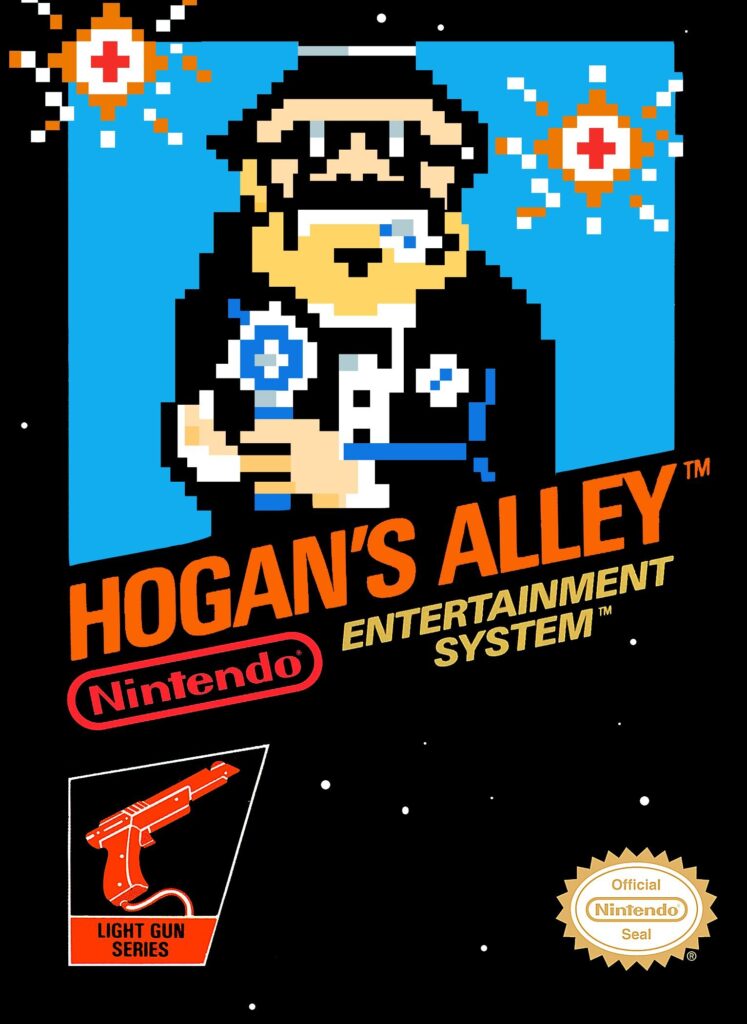
The “real” Hogan’s Alley was at Camp Perry, Ohio. Apparently, at some point in the 1920s/1930s, the US Government realized that police departments were carrying weapons. And the end result of carrying these weapons was a tendency to use them. Most departments didn’t have ANY training at the time. There was no use of force training. No range to practice and ensure that policemen could actually hit what they were aiming at. This lack of training apparently lead to situations where police were hitting things (citizens) that they hadn’t been aiming at. In a strange move, the government and the NRA (I know!) decided that some sort of training should be created. The end result was the Special Police School, which provided the sort of training that should have been around in the first place. And the shining diamond in the middle of the SPS was Hogan’s Alley, a firing range where police could be trained on engaging targets. Cardboard cutouts started out thin-side to the police, then rotated 90 degrees, forcing the policemen on the range to decide whether to shoot a tommy-gun toting gangster or a mother holding a child. It was the first training in the country to teach this sort of discipline.
The initial Hogan’s Alley was clearly the inspiration for this game. It follows the exact same methodology. In the first game mode, three paper targets slide onto the “range” with the thin side towards the shooter, then rotate to present the paper to the shooter. Players shoot the baddies, don’t shoot the good guys, and get points for following these relatively simple rules. After a set number of “misses” (either shooting good guys or letting the bad guys get away) the game is over. The second mode follows the same rule set, but moves through a cityscape. There’s also a “trick shot” mode where the shooter bounces cans across the screen, hitting the small targets to keep them in the air and guide them into openings on the left side. Players make points for getting the cans across the screen, and cans that fall off the screen count as misses.
While I can’t play this one because I don’t have a Zapper compatible with my TV or computer screen, I remember this game being challenging. The quick draw, decision based shooting was fun, a little hard, and rewarding when you got it right. The music fits (especially the jazz drums on the city mode making it seem like a 1930s gangster movie). The trick shot mode was HARD, which was good. (you could always “cheat” the game by getting close, and I remember doing that too.)
(Side note (on an article filled with side notes) When the FBI opened their city-based live fire course for the Hostage Rescue Team, they named it Hogan’s Alley. While some would say it was an homage to the original at Camp Perry, the fact that the new Alley was opened 3 years after the game was released is pretty telling. The course is still there, and just about every shooting course based in a city setting, including the one for the Secret Service, is called a Hogan’s Alley as well).
WILD GUNMAN
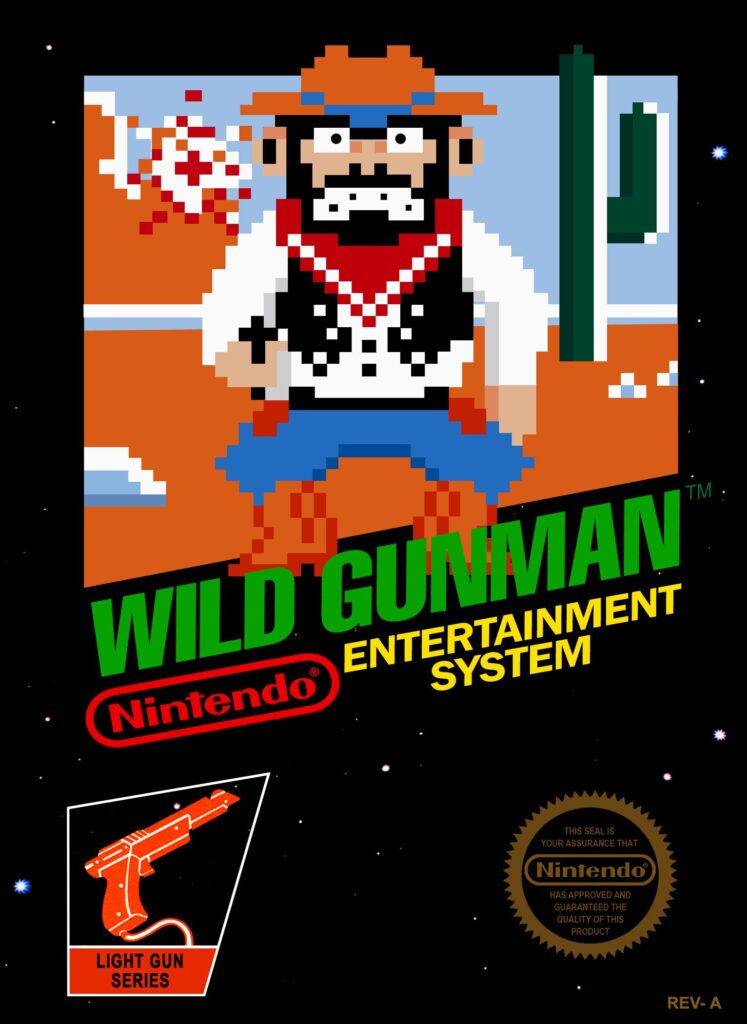
In Wild Gunman, we actually get our first game remade for the NES. The original Wild Gunman actually came out more than 11 years earlier, and was based on a similar system to the Laser Clay system, where it used 16 mm footage and a laser. The footage moves you through a city, and when the baddie’s eyes flash, the player quick draws and shoots. If you flash leather faster, the baddie goes down. If you’re too slow, game over.
I mean, how cool is that? There STILL aren’t games like that.
The NES version follows a similar pattern, but instead of 16mm realistic footage, it uses more “traditional” Nintendo sprites. The bad guys walk on to the screen, shout at you to draw, and then you’re supposed to quick draw faster than the baddie. There’s a warning of how fast the bad guy will shoot, and if you draw faster and hit, you get bonus points for the time faster than the bad guy. If you don’t out draw and hit, the screen flashes red and you “die.” The bad guys get faster over time, starting at 1.2 seconds, and then moving down to less than half a second. If you shoot early, you’ll “foul” and it counts as a loss. After 3 losses, the game is over. There’s also a 2 outlaw mode, where two bad guys come out at once, with different shooting speeds, forcing the shooter to prioritize. Finally there’s a “gang” mode, which flows through a city scene. This time, instead pf waitng for the baddies to shoot, you’re limited on ammunition, and over time, the outlaws come faster, draw more quickly, and you’ll even get non-combatants to show.
As it’s a “kid’s game” on a family system, the “deaths” of the bad guys are pretty tame. At WORST they fall backwards, dead. In some cases, hats fly off or pants fall down instead. When the player dies, the screen flashes red, the first few news of Chopin’s Funeral March play, and the bad guy holds sign staying “you lost.”
Overall, the gameplay is pretty good. While the first two modes are designed for quick draw, and most kids didn’t have a holster rig to quick draw, most would simply point the gun at the screen and shoot as soon as the signal was given. With a 1.2 second reaction time, and firing being only a trigger pull away, that mode got boring very quickly. If you mimed quick drawing, some skill would come back., as speed and aiming reentered the equation. The final mode, especially after the non-shooters show up, actually forced some skill in aim, speed, and the ability to not shoot the bartender.
Personally, this was my favorite of the first 3 shooting games, mostly for the challenge of the “gang mode.” My friends and I would challenge each other to for a high score. It’s the one of these I REALLY wished I had a gun that would work on a modern TV. (side note, there actually is one now. it’s made to work with an actual NES, and it DOES work with a LCD TV. it’s 25 bucks, made by retro-game company Hyperkin, and can be bought here.)
Fun final note on Wild Gunman…there wasn’t actually ever a single-game cabinet based on the NES game, despite what everybody thought. While NES did release it as part of the the Playchoice-10 Cabinet (literally a game cabinet designed to play the NES in an arcade), as a stand alone game, it exists ONLY in the Hill Valley universe of the Back to the Future Movies.
The cabinet was made specifically for the movie, and mostly to set up the fact that Marty McFly actually COULD shoot prior to the trip to the Wild West in BTTF3.
NES was eventually in on the joke, releasing a stand alone version for the Wii U for Back to the Future Day in 2015.
DUCK HUNT
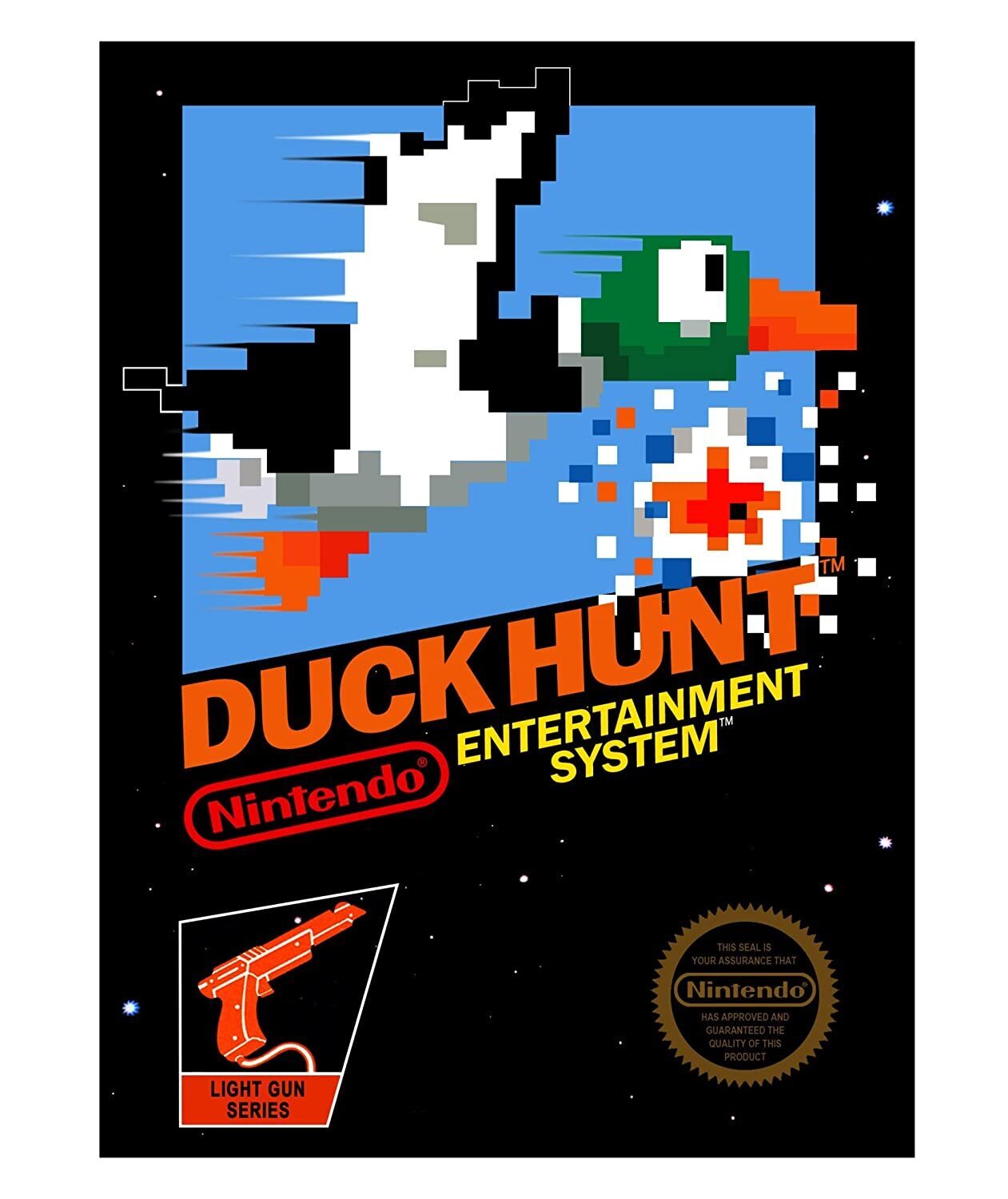
I’ve saved the best-known of the original zapper games for last, simply because nobody reads these posts, and if they do, they’re frantic for hard-nosed NES news on games released 35 years ago. So here’s some hot takes on Duck Hunt
This is one of the best “selling” games of the NES, (like Super Marop Bros) because it was released with the parent system. Once the Zapper was released as a bundle purchase, the Super Mario Bros/Duck Hunt dual cartridge was released along side. That cartridge is almost automatically associated with the system itself. EVERYBODY had the 2 controllers/zapper/SMB-DH system.
And honestly, that probably made the system sell well.
Duck Hunt, itself, is a pretty simple game. Players choose one of three game modes: single duck, double duck, or skeet shooting mode. The dog (cleverly named Dog) jumps into the weeds and flushes out ducks for the shooter. There are three types of duck which move at different speeds depending on color. Players get 3 shots per round, and must shoot a set number of ducks per round to advance to the next one. The game ends when players don’t advance.
And then the fucking dog laughs at you.
(I tried to think of the worst villain on the NES. Bowser came to mind. The alien at the end of Contra. The oil slick in RC Pro Am.
There isn’t a worse villain than the damn dog in Duck Hunt. Not being able to shoot the dog was the greatest mistake Duck Hunt ever made.)
Anyway, the great thing about Duck Hunt was that it was challenging. It wasn’t hard, at least at first. And yes, like the other Zapper games, you could get close to the screen. But even that had it’s challenges, as the ducks’ starting location was random, and their movement was too. Playing skeet shooting made it even harder, as the game used perspective to made the clays get smaller the farther “away” they were from the shooter, forcing quick reaction AND good aim.
And (here’s a part of the game most people don’t know) it was even a two player game. The Second player could use a controller to move the ducks around.
The end result was a game that is almost as associated with the NES as Super Mario Bros. EVERYBODY knows Duck Hunt. EVERYBODY has played it.
And EVERYBODY HATES THAT FUCKING DOG.
So there you have it. 2300 words on the first three light gun games.
I’m gonna have to start making these much, much shorter. Seriously. I have more than 700 games left to review. If I average 750 words per game, I’m NEVER going to finish. And the end product will rival War and Peace. Which is cool, but I’m not Tolstoy, and the NES isn’t Russian History. Mostly I’m not Tolstoy.
I’m hoping this gets better when I get to a few games released at once. The sheer mass of these first games are intimidating. I’m hoping it gets better. Ands the good news is that I have most of the next few posts already done. So maybe it won’t be 20 days per game, which is about what I’m averaging right now. Here’s hoping.
Categories: Gameplay/Reviews NES NES History